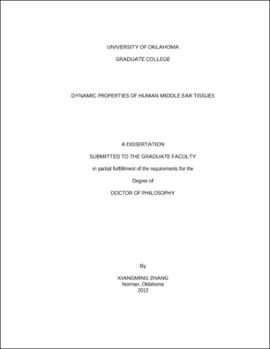| dc.contributor.advisor | Gan, Rong Z. | |
| dc.creator | Zhang, Xiangming | |
| dc.date.accessioned | 2019-06-07T01:03:25Z | |
| dc.date.available | 2019-06-07T01:03:25Z | |
| dc.date.issued | 2013 | |
| dc.identifier | 9961356602042 | |
| dc.identifier.uri | https://hdl.handle.net/11244/320331 | |
| dc.description.abstract | Middle ear tissues, including the tympanic membrane (TM), round window membrane (RWM) and stapedial annular ligament (SAL), play important roles in acoustic transmission function in the middle ear. Changes of mechanical properties of ear tissues caused by diseases may induce the conductive hearing loss. It is critical to measure the mechanical properties of these tissues for understanding the middle ear transfer function and the mechanism of hearing loss. However, there are limited reports about mechanical properties of middle ear tissues in the literature because of the extreme small size and complicated geometry of these tissues. Moreover, most of published studies focused on mechanical properties under the static or quasi-static condition. As the middle ear tissues undergo vibration in the auditory frequency range, the dynamic properties or complex moduli of the tissues may have more realistic value than the static properties. The dynamic properties of middle ear tissues will provide the accurate data for modeling of human ear. | |
| dc.description.abstract | In this study, the dynamic properties of human TM, RWM and SAL specimens harvested from cadaver temporal bones were measured in the auditory frequency range. The generalized linear solid model was used to describe the viscoelastic behaviors of these tissues. Two different approaches were used to measure ear tissues. The first approach of using acoustic driving was developed for membrane tissues, such as TM and RWM. Vibration of the membrane specimens in response to acoustic driving load applied to the specimen was measured by laser Doppler vibrometer over the frequency range of 200-8000 Hz. The dynamic experiments were then simulated in finite element models by acoustic-structure coupled analysis in ANSYS. Dynamic properties of the TM and RWM were derived by inverse-problem solving method. | |
| dc.description.abstract | The second approach was using dynamic mechanical analyzer based on the frequency-temperature superposition principle. The dynamic tests were conducted for the TM and SAL specimens at the frequencies from 1 Hz to 40 Hz at three different temperatures: 5o, 25o and 37oC. The frequency-temperature superposition principle was applied to expand the test frequency range to a much higher level (at least 3760 Hz). The viscoelastic parameters and the complex moduli in the frequency domain were obtained and the results were comparable to the published data. The potential effects of the experimental condition and specimen dimension measurement on the results were estimated. | |
| dc.description.abstract | The methods and results reported in this study contribute to soft tissue biomechanics. The complex moduli of middle ear tissues can be applied into finite element model of human ear to improve the model accuracy. | |
| dc.format.extent | 123 pages | |
| dc.format.medium | application.pdf | |
| dc.language | en_US | |
| dc.relation.requires | Adobe Acrobat Reader | |
| dc.subject | Middle ear--Physiology | |
| dc.subject | Middle ear--Mechanical properties | |
| dc.subject | Tympanic membrane | |
| dc.title | DYNAMIC PROPERTIES OF HUMAN MIDDLE EAR TISSUES | |
| dc.type | text | |
| dc.type | document | |
| dc.thesis.degree | Ph.D. | |
| ou.group | College of Engineering::Department of Bioengineering | |
